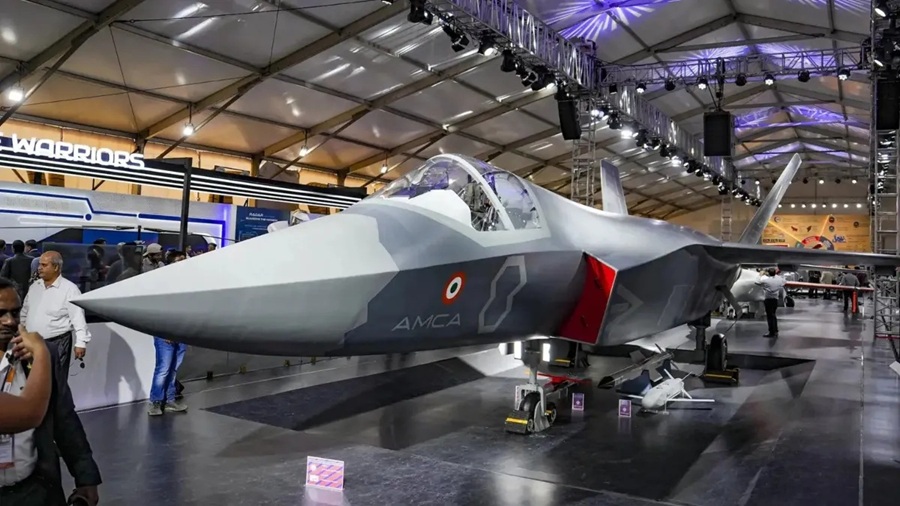In a major push toward self-reliance and modernization of its armed forces, the Government of India has officially approved the development of its first indigenous fifth-generation fighter jet — the Advanced Medium Combat Aircraft (AMCA). The decision marks a critical milestone in India’s aviation history and positions the country among a select group of nations developing next-generation stealth fighter technology.
The project, jointly executed by the Aeronautical Development Agency (ADA) and Hindustan Aeronautics Limited (HAL), is expected to dramatically reshape India’s defense landscape, boost indigenous manufacturing, and counter growing regional threats.
What is the AMCA?
The AMCA is a fifth-generation multirole stealth fighter jet designed to fulfill the Indian Air Force’s (IAF) future needs for air dominance, deep strike, and electronic warfare capabilities. It features a stealthy design, internal weapons bays, supercruise capabilities, and advanced avionics that can rival foreign counterparts like the U.S. F-35, China’s J-20, or Russia’s Su-57.
Unlike fourth-generation aircraft, fifth-generation fighters like the AMCA incorporate stealth from the design stage, use next-gen sensors and AI-assisted systems, and are capable of operating in highly contested, electronic warfare-rich environments.
The AMCA will be developed in two variants:
Mark 1: Featuring a stealth design with existing 4.5-generation engines (initially the GE F414).
Mark 2: Planned for the 2035–2040 timeframe, equipped with indigenous sixth-generation engines and even more advanced capabilities.
Government Approval and Budget
The Indian government, through the Cabinet Committee on Security (CCS) chaired by Prime Minister Narendra Modi, approved the AMCA program in early 2024 with an initial outlay of over ₹15,000 crore (approximately $1.8 billion) for prototype development, testing, and infrastructure. This includes funding for two flying prototypes, multiple testbeds, and the establishment of a dedicated final assembly line.
This move is a major vote of confidence in India’s domestic defense research and development ecosystem and falls squarely under the Modi government’s ‘Aatmanirbhar Bharat’ (Self-Reliant India) initiative. The goal is not only to equip the Indian Air Force with cutting-edge technology but also to reduce dependency on foreign suppliers and foster an export-ready defense industry.
Key Players Involved
Several Indian defense and aerospace companies will play a crucial role in the AMCA’s development:
1. Aeronautical Development Agency (ADA)
The lead design agency under the Defence Research and Development Organisation (DRDO).
Responsible for systems integration, design validation, and flight testing.
2. Hindustan Aeronautics Limited (HAL)
The production partner, HAL will manufacture the AMCA at a new dedicated facility.
HAL is also currently producing Tejas fighters, and its expertise will be critical in scaling up AMCA production.
3. Bharat Electronics Limited (BEL), Bharat Dynamics Ltd (BDL), and private firms like L&T, Godrej Aerospace, and Tata Advanced Systems
These companies are expected to supply critical components, subsystems, composites, avionics, and precision weapons.
The engine for the initial AMCA Mk1 will be a twin GE F414 powerplant, similar to that selected for the Tejas Mk2. Talks are ongoing with General Electric for technology transfer. For the Mk2 version, India is exploring joint development of a high-thrust engine with countries like the U.S. (through GE), France (Safran), or the UK (Rolls-Royce).
Timeline: When to Expect It
2024–2028: Detailed design, prototype construction, wind tunnel testing, and systems integration.
2028: First prototype rollout and maiden flight.
2029–2032: Extensive flight testing and validation.
2032 onwards: Start of limited series production (LSP) and induction into the Indian Air Force.
The AMCA is expected to be inducted in limited numbers by 2032–2033, with full operational capability in the mid-2030s. The IAF has expressed interest in acquiring at least 120 AMCA units, making it one of the largest indigenous defense programs in Indian history.
Why It Matters
India’s move toward a fifth-generation fighter comes amid an increasingly complex regional security environment:
China already fields the J-20 stealth fighter and is testing its FC-31.
Pakistan is reportedly in talks to acquire Chinese FC-31s to counterbalance India’s air advantage.
India's older jets, including the MiG-21 and Jaguars, are rapidly aging out of service.
In this context, the AMCA is not just a technological upgrade — it is a strategic imperative. With the risk of a two-front war looming and an arms race intensifying in Asia, the ability to field a domestically built stealth fighter will give India greater autonomy and deterrence.
Challenges Ahead
Despite the enthusiasm, there are challenges:
Developing stealth materials and radar-absorbent coatings domestically.
Integration of AI-enabled avionics, advanced sensors, and secure data links.
Achieving high production quality and meeting timelines — areas where HAL has historically faced delays.
Developing an indigenous engine in time for the Mk2 variant.
However, with strong political backing, industry collaboration, and lessons learned from the Tejas program, India appears far better prepared this time.
Conclusion
The approval of the AMCA project is a giant leap in India’s aerospace journey. It symbolizes not just a defense upgrade, but a national ambition — to create world-class military technology, assert strategic autonomy, and emerge as a global defense manufacturer.
If successful, the AMCA will not only secure Indian skies for decades to come but could also open doors to international defense exports — establishing India as a credible fifth-generation fighter manufacturer in the global arena.
